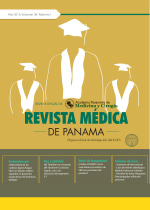Algoritmo De Selección De Receptores Altamente Sensibilizados En Lista De Espera Modalidad Donante Fallecido En Panamá. 2021
Autores/as
DOI:
https://doi.org/10.37980/im.journal.rmdp.20211833Palabras clave:
Antígenos de Leucocitos Humanos (HLA), polimórfico, algoritmo, antibody reactive panelResumen
El Sistema de antígenos de Leucocitos Humanos (HLA) juega un papel funcional en la presentación de péptidos al sistema Inmune. El grado de compatibilidad de los antígenos de los leucocitos humanos (HLA) de los loci -A, -B, -DRB1 entre el receptor en lista de espera y el donante, y la ausencia de anticuerpos específicos contra los antígenos HLA del donante, tienen la mejor sobrevida en un trasplante. El nuevo algoritmo de selección de receptores sensibilizados en lista de espera, que se introduce en el presente trabajo, tiene como objetivo mejorar su posibilidad de recibir riñones provenientes de un donante fallecido. Este algoritmo cumple etapas que se siguen en la selección del receptor sensibilizado compatible con el donante fallecido. Previo a incorporar un paciente en la lista de espera, es requisito conocer el grado de sensibilización a los antígenos del sistema de Leucocitos Humanos (HLA). El Laboratorio Nacional de Trasplante ha incorporado el Panel Reactivo de Anticuerpos Calculado (cPRA) que utiliza la frecuencia de antígenos HLA de la población panameña, en sustitución del Panel Reactivo de anticuerpos (PRA) que utiliza la frecuencia de alelos de otra población que no es la panameña.
Publicado
Número
Sección
Licencia
Derechos de autor 2021 Infomedic Intl.Derechos autoriales y de reproducibilidad. La Revista Médica de Panama es un ente académico, sin fines de lucro, que forma parte de la Academia Panameña de Medicina y Cirugía. Sus publicaciones son de tipo acceso gratuito de su contenido para uso individual y académico, sin restricción. Los derechos autoriales de cada artículo son retenidos por sus autores. Al Publicar en la Revista, el autor otorga Licencia permanente, exclusiva, e irrevocable a la Sociedad para la edición del manuscrito, y otorga a la empresa editorial, Infomedic International Licencia de uso de distribución, indexación y comercial exclusiva, permanente e irrevocable de su contenido y para la generación de productos y servicios derivados del mismo. En caso que el autor obtenga la licencia CC BY, el artículo y sus derivados son de libre acceso y distribución.






